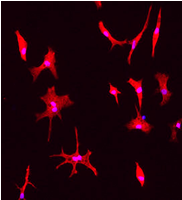Zoeken naar het ontstaan van de ziekte van Parkinson
Bij de ziekte van Parkinson sterven hersencellen af die de neurotransmitter dopamine produceren. Maar wat veroorzaakt dit? Er zijn aanwijzingen dat de problemen beginnen in het afweersysteem in de hersenen. Dr. Amalia Dolga, assistent hoogleraar bij de afdeling Moleculaire Farmacologie van de Rijksuniversiteit Groningen (RUG), heeft nu een subsidie ontvangen van de Stichting ParkinsonFonds om dit te onderzoeken in cellen afkomstig van patiënten.
Parkinson is een neurodegeneratieve ziekte, waarbij dopamine producerende hersencellen afsterven, wat er voor zorgt dat patiënten hun spieren niet goed meer kunnen aansturen. Het is niet bekend waarom die hersencellen afsterven. “We denken dat afweercellen in de hersenen, de zogeheten microglia, een rol kunnen spelen”, vertelt Amalia Dolga. Een klassiek symptoom van de ziekte van Parkinson is de vorming van Lewy lichaampjes in hersencellen. “Dit zijn klonteringen van een eiwit met de naam alfa-synucleïne. Normaal gesproken ruimen de microglia die klontjes op. Er zijn aanwijzingen dat de symptomen van de ziekte van Parkinson ontstaan wanneer dit niet gebeurt.”

Nieuwe techniek
Samen met haar RUG-collega prof. dr. Arjan Kortholt, adjunct hoogleraar Cel Biochemie, heeft Dolga een subsidie van €250.000 ontvangen van het Nederlandse ParkinsonFonds, om uit te zoeken wat er mis gaat bij de microglia. Een probleem is dat het bijna onmogelijk is om hersencellen van patiënten te krijgen. Maar Dolga heeft een nieuwe techniek ontwikkeld om deze cellen te kweken uit stamcellen. Die techniek begint met gewone lichaamscellen van de patiënt, die ze met een speciale behandeling transformeert in ongespecialiseerde stamcellen. Vervolgens laat ze die stamcellen specialiseren tot microglia. “Deze methode is nog erg nieuw, mijn lab is het eerste in Nederland die dit kan”, vertelt Dolga.

Enzym
Kortholt heeft al meer onderzoek gedaan naar de ziekte van Parkinson. “We hebben een aantal mutaties bestudeerd, en denken dat een enzym met de naam LRRK2 een cruciale rol speelt”, vertelt hij. Bij patiënten werkt dit enzym door de mutaties te hard. “In een aantal gevallen gebeurt dat door een mutatie in het LRRK2 gen, maar soms zit de mutatie in een ander gen maar heeft het wel invloed op LRRK2”, vat hij zijn resultaten samen.
Menselijke cellen
Een mogelijk gevolg van de mutaties is dat de mitochondriën, die motoren van de cel, niet goed werken. Dolga heeft deze celorgaantjes bestudeerd onder omstandigheden van zuurstof-stress en bij celdood. “Wat we willen weten is hoe mitochondriën werken bij patiënten met Parkinson. Er is al veel onderzoek naar gedaan in proefdieren, maar die zijn niet altijd een goed model voor mensen. Daarom willen wij met menselijke cellen werken.”
Samen met een postdoc die de techniek al beheerst zal Dolga microglia gaan maken van de cellen van Parkinson patiënten met vier verschillende typen mutaties. “In deze cellen zullen we een aantal eigenschappen onderzoeken, van energieproductie tot het vermogen om richting een eiwitklontje te kruipen en dit op te slokken”, legt Dolga uit. De cellen van patiënten komen van het Deutches Zentrum für Neurodegenerative Erkrankunngen (Duits centrum voor neurodegeneratieve ziekten) in Tübingen en van het Erasmus Medisch Centrum in Rotterdam, in samenwerking met prof. Vincenzo Bonifati. Deze onderzoekscentra leveren materiaal van drie patiënten voor vier verschillende mutaties.
Ontstaan
Het onderzoeksproject moet duidelijk maken wat de bijdrage van de afweercellen is aan het ontstaan van de ziekte van Parkinson. Kortholt: “Er is nog steeds discussie over de vraag of het een hersenziekte is, een ziekte van het afweersysteem of allebei.” Bovendien kijken de onderzoekers ook naar twee mutaties in andere genen dan LRRK2, om te zien of die dit enzym ook beïnvloeden.
Omdat LRRK2 een rol speelt bij de symptomen van veel patiënten wil Kortholt ook graag de effecten van een LRRK2 remmer bestuderen. “Er zijn verschillende soorten remmers, maar de meeste daarvan hebben ook een effect in andere organen, zoals de nieren. Dat zorgt voor ernstige bijwerkingen dus die zijn niet geschikt als geneesmiddel.” Kortholt heeft inmiddels enkele remmers ontdekt die de activiteit van LRRK2 niet helemaal platleggen, maar halveren. “Die lijken geen bijwerkingen te hebben. We willen die daarom testen op menselijke cellen.”

ParkinsonFonds
De subsidie van de Stichting ParkinsonFonds stelt de onderzoekers in staat om de komende twee jaar op zoek te gaan naar de oorzaak van de ziekte van Parkinson. Het ParkinsonFonds heeft de afgelopen twintig jaar zo’n 18 miljoen euro uitgegeven aan wetenschappelijk onderzoek. Aanvragen die het fonds ontvangt worden beoordeeld door een internationaal panel van deskundigen. Het is opvallend dat Dolga en Kortholt nu geld krijgen, het is de eerste keer dat een subsidie gaat naar onderzoekers die geen arts zijn. Maar met hun gecombineerde kennis over de ziekte van Parkinson en het kweken van microglia uit cellen van patiënten hopen ze een stap dichter bij een behandeling te komen.
Meer informatie
- prof. dr. Arjan Kortholt https://www.rug.nl/staff/a.kortholt/
- Amalia M. Dolga, PhD https://www.rug.nl/staff/a.m.dolga/
Illustratie: the human differentiated microgliaMeer nieuws
-
19 december 2025
Mariano Méndez ontvangt Argentijnse RAÍCES-prijs
-
18 december 2025
Waarom innoveren, en voor wie?
-
17 december 2025
Ben Feringa wint Feynmanprijs
